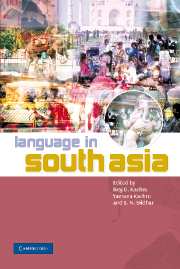Book contents
- Frontmatter
- Contents
- List of Figures
- List of Maps
- List of Tables
- Preface
- Acknowledgments
- List of Abbreviations
- Note on Transcription
- Introduction: languages, contexts, and constructs
- Part 1 Language history, families, and typology
- Part 2 Languages and their functions
- Part 3 Sanskrit and traditions of language study
- Part 4 Multilingualism, contact, and convergence
- Part 5 Orality, literacy, and writing systems
- Part 6 Language conflicts
- Part 7 Language and modernization
- Part 8 Language and discourse
- Part 9 Language and identity
- 22 Language and gender
- 23 Dalit literature, language, and identity
- 24 Language and youth culture
- Part 10 Languages in diaspora
- References
- Subject Index
- Language Index
- Author Index
23 - Dalit literature, language, and identity
Published online by Cambridge University Press: 04 May 2010
- Frontmatter
- Contents
- List of Figures
- List of Maps
- List of Tables
- Preface
- Acknowledgments
- List of Abbreviations
- Note on Transcription
- Introduction: languages, contexts, and constructs
- Part 1 Language history, families, and typology
- Part 2 Languages and their functions
- Part 3 Sanskrit and traditions of language study
- Part 4 Multilingualism, contact, and convergence
- Part 5 Orality, literacy, and writing systems
- Part 6 Language conflicts
- Part 7 Language and modernization
- Part 8 Language and discourse
- Part 9 Language and identity
- 22 Language and gender
- 23 Dalit literature, language, and identity
- 24 Language and youth culture
- Part 10 Languages in diaspora
- References
- Subject Index
- Language Index
- Author Index
Summary
Introduction
In 1972 a new literary movement burst on the Marathi language scene, Dalit Sahitya (literature of the oppressed), accompanied by a militant group who called themselves Dalit Panthers. Now a thirty-year-old phenomenon that is still in a creative and growing phase, the Dalit Sahitya movement has spread to half the states in India. The poets and writers of the movement added a term to the all-India vocabulary; the word “Dalit” is used now in most publications. It replaces the descriptive name of Untouchable or ex-Untouchable (now that the practice of untouchability is illegal); Gandhi's compassionate but patronizing appellation, Harijan (Children of God); and, when appropriate, the official term of Scheduled Caste. Dalit is a self chosen word derived from the Sanskrit and Marathi word for ground down, broken, that is oppressed, but Dalit is used to indicate that untouchability is imposed by others, not a result of inherent pollution. It is also used to be inclusive of all the deprived and oppressed of India.
Although it seemed new to the English speaking world in the 1970s, Dalit literature began to appear in the 1950s and 1960s as part of the movement led by Dr B. R. Ambedkar (1891–1956), undisputed leader of India's Untouchables. The newspapers of Dr Ambedkars time published some Dalit stories and poems during the 1940s and 1950s most importantly the short stories of Bandhu Madhav. In the late 1950s and 1960s, five important writers were being published in Maharashtra.
- Type
- Chapter
- Information
- Language in South Asia , pp. 450 - 465Publisher: Cambridge University PressPrint publication year: 2008
- 4
- Cited by



